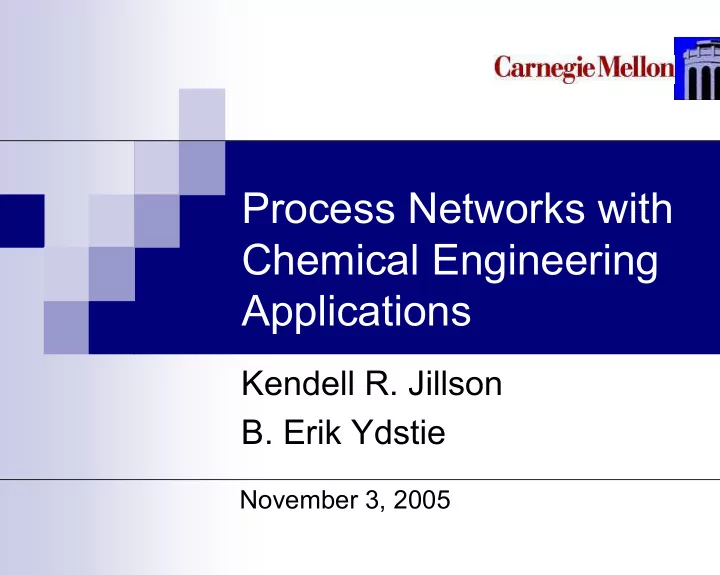

Process Networks with Chemical Engineering Applications Kendell R. Jillson B. Erik Ydstie November 3, 2005
Objectives � Describe a systematic framework for modeling process networks � Develop passivity based methods for stability analysis and control of process networks � Establish a variational principle for process networks � Develop a reactor-diffusion network and a plant-wide control case study
Process Networks P � Define � Graph, G = (P,T,F) F � Process (node) � Terminal T � Flow � Inventory of each node, v j � Extensive quantities, conserved at each node � e.g. � Potential of each node, w j � Intensive quantities, continuous around any loop � e.g. � Potential differences ( W ) act as driving forces for flow through constitutive relationships
Examples of Process Networks � Supply Chain Networks � Process Flowsheets � Biological Systems � Chemical Reaction Pathways
Passivity Background � Passivity theory is used to show network stability � Originated from electrical circuit theory � A feedback or parallel connected system of passive subsystems is also passive � Passivity inequality � With x,u,y the states, inputs, and outputs to the network � . � Network is strictly passive if � Problem: To find a practical storage function
Exploitation of Entropy to Develop a Storage Function a(v 1 ) v 1 v* a(v) > 0, w ≠ w* a(v) = 0, w = w* Tangent line with slope w*
Storage Function Defined � At each node: � For the whole network � Differentiation and using deviation variables gives
� Use a result similar to Tellegen’s Theorem (Proof shown in Jillson,Ydstie 2005) � Based only on topology of network � Substituting into the previous equation Flow between Boundary Production nodes conditions within nodes
Passivity of Process Networks � If Then Network is Strictly Passive! u T y x T x � True for positive constitutive flow and production rates
Multi-component Flow w 1 w 2 f 12 1 2 � Inventories and Potentials � Convective and Diffusive Flow
� Using the Gibbs-Duhem equation � Plugging in this expression into the flow equation and integrating over a length, L , gives: � Potential - Flow relationship is positive
Reactor-Distillation Model (similar to Kumar and Daoutidis, 2002) � Reactor Model: CSTR: A � B � C with 1 st order kinetics � Distillation Model: � CMO � 15 trays � Saturated Liquid Feed on 4 th tray � Constant Relative volatilities {4,2,1} � Fixed Feed rate and purge ratio � 10 flows, 5 units (not counting flows within the distillation column)
Pressure driven flows � Mass of each species in each unit � inventory � Introduce the pressure of each unit as a function of the total mass � potential � Bulk flow between units would be a linear function of the differences in pressure � Control laws could be written to derive the k values, e.g: � Problems arise with recycle loops, due to non - passive pump units
Inventory Controllers � For total mass in four units � At steady state, these become units’ mass balances � Account for 4 degrees of freedom, leaving 6 remaining
Remaining Degrees of Freedom � Inventory control on single component ( A ) in reboiler � Fixed Feed rate � Fixed Purge Ratio � Fixed Reflux � Mass Balance Constraints on Distillation Column
Simulation Results � For a step change in the fixed feed rate (at t=500 from F 0 = 100 to 150) and a change in the set point of the number of moles of A in the reboiler (at t = sp = 9 to 1000 from N A b 2 (in effect changing x A from 0.050 to 0.011):
Variational Principle for Process Networks � Define the entropy production Contribution due to flow Contribution due to production � For the complete network
Optimality � Theorem: The total entropy production is minimized along all system trajectories for fixed node and terminal potentials, and positive monotonic constitutive expressions (Proof in Jillson, Ydstie 2005)
Reactor Network Example � Three reactor nodes, and three terminals � Reaction: A+B � C � Transport governed by diffusion 9 ODE’s 27 Algebraic constitutive equations
Control of Example � Objective: Control flow rate of C at T3 � Stabilized by a PI flow controller (K = 50, 1/ τ = 10) to a set - p oint, fc(3) = 0.05 fC(3) � y L3,3 of fC � u
Optimality Result � Minimal entropy production in unperturbed solution, compared to a randomly perturbed network
Conclusions � Process Networks modeled as a graph with state v and potential w at each node � Storage function, A , used to show passivity provided flow and production rates are monotonic and positive � Simulation examples presented to demonstrate theory
Acknowledgments � Research funded by: NSF CTS-ITR 031 2771 � Ydstie Research group
Recommend
More recommend